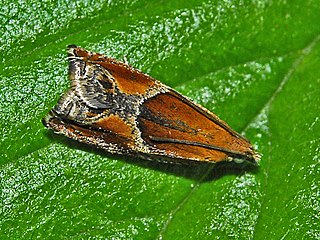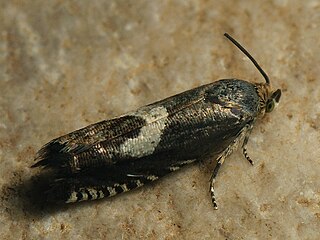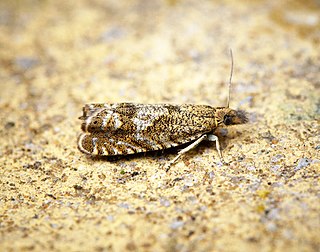
Eudocima salaminia, the green fruit-piercing moth, is a moth of the family Erebidae. The species was first described by Pieter Cramer in 1777. It is found from India, and across south-east Asia to the Pacific Islands. In Australia it occurs in the Northern Territory, Queensland and New South Wales. The adult is a fruit piercer.

Epinotia pygmaeana, the pygmy needle tortricid, is a moth of the family Tortricidae. It is found across the Palearctic from northern and central Europe to eastern Russia.

Epinotia nisella is a moth of the family Tortricidae which is found in the Palearctic, Europe and North America. It was first described by Carl Alexander Clerck in 1759.

Eriopsela quadrana is a moth of the family Tortricidae. It is found in most of Europe, east to the eastern part of the Palearctic realm.

Grapholita compositella, the clover seed moth, is a moth of the family Tortricidae. It is found from Europe to Asia Minor, Mongolia, China and eastern Russia. It is also present in North America.

Grapholita internana is a moth of the family Tortricidae. It is found in most of Europe, except the Balkan Peninsula and Fennoscandia.

Epinotia tetraquetrana, the square-barred bell, is a moth of the family Tortricidae. It is found from most of Europe east to the Near East and the eastern part of the Palearctic realm.

Pammene regiana is a species of moth of the family Tortricidae. It was described by Zeller in 1849. It is found in most of Europe, except the Iberian Peninsula, most of the Balkan Peninsula, Lithuania and Ukraine.

Semioscopis avellanella is a species of moth of the family Depressariidae. It is found in most of Europe east to the eastern parts of the Palearctic realm.

Grapholita janthinana, the hawthorn leafroller, is a moth of the family Tortricidae. It was described by Philogène Auguste Joseph Duponchel in 1843. It is found in most of Europe, except most of the Balkan Peninsula, Ukraine, Lithuania and Estonia. The habitat consists of hedgerows, gardens and woodland edges.

Grapholita tenebrosana, the Grapholitha roseticolana, is a moth of the family Tortricidae. It was described by Philogène Auguste Joseph Duponchel in 1843. It is found from most of Europe east to Japan. The habitat consists of woodland, gardens, orchards, parks and scrubs.

Pammene populana, the pygmy piercer, is a species of moth of the family Tortricidae. It is found in most of Europe, except Portugal, the Balkan Peninsula and Ukraine. The habitat consists of woodland, marshes, riverbanks, fens and sand dunes.

Ancylis obtusana, the small buckthorn roller, is a moth of the family Tortricidae.

Epinotia abbreviana is a moth of the family Tortricidae. It is found in Europe and was first described by Johan Christian Fabricius in 1794.

Grapholita orobana is a moth belonging to the family Tortricidae. The species was first described by Georg Friedrich Treitschke in 1830. It is native to the Palearctic.

Cydia coniferana is a Palearctic moth belonging to the family Tortricidae. The species was first described by Saxesen in 1840. The wingspan is 11–13 mm. The forewings are dark fuscous, the costa posteriorly with white strigulae, some ending in obscure leaden-metallic marks. There is an irregular erect white dorsal median spot, including a dark fuscous strigula. The ocellus is edged with leaden-metallic, and crossed by several black dashes. The hindwings are fuscous. The larva is dull yellowish ; head pale brown

Pammene argyrana is a species of moth belonging to the family Tortricidae.

Dichrorampha plumbagana is a moth belonging to the family Tortricidae first described by Georg Friedrich Treitschke in 1830.

Dichrorampha plumbana is a moth belonging to the family Tortricidae first described by Giovanni Antonio Scopoli in 1763. It is native to the Palearctic including Europe.

Epiblema costipunctana is a species of moth belonging to the family Tortricidae. It is native to Europe.





















